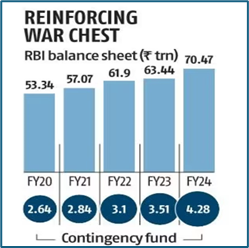Why in news?
The Reserve Bank of India (RBI) reported a 17% increase in its FY24 income to ₹2,75,572.32 crore. Its balance sheet grew 11.08 per cent to Rs 70.47 lakh crore in the fiscal ended March 31, 2024.
What’s in today’s article?
- Sources of income of RBI
- Key highlights of the financial performance of RBI
How does the RBI make money?
- Interest on Loans and Advances:
- To Commercial Banks
- The RBI lends money to commercial banks and charges interest on these loans, typically through mechanisms like the repo rate.
- To the Government
- The RBI also provides temporary loans to the government through mechanisms like Ways and Means Advances (WMA).
- WMA is a facility for both the Centre and states to borrow from the RBI.
- These borrowings are meant purely to help them to tide over temporary mismatches in cash flows of their receipts and expenditures.
- Section 17(5) of the RBI Act, 1934 authorizes the central bank to lend to the Centre and state governments subject to their being repayable “not later than three months from the date of the making of the advance”.
- The interest rate on WMA is the RBI’s repo rate, which is basically the rate at which it lends short-term money to banks.
- Investments in Government Securities
- The RBI invests in various government securities (bonds, treasury bills).
- The interest earned on these investments constitutes a significant portion of its income.
- Foreign Exchange Operations
- The RBI holds and manages India’s foreign exchange reserves.
- It earns income from investing these reserves in foreign assets, such as US Treasury bonds and other high-quality foreign securities.
- The RBI also profits from the buying and selling of foreign currencies.
- Issue of Currency
- The RBI has the exclusive right to issue currency in India.
- It earns seigniorage, which is the difference between the value of money and the cost to produce it.
- For instance, if it costs Rs. 1 to print a Rs. 200 note, the seigniorage profit is Rs. 199.
- Management of Government Accounts
- The RBI acts as a banker to the government.
- It manages the government’s accounts, collects taxes, and disburses payments. The RBI charges the government for these services.
- Fees and Commissions
- The RBI charges fees and commissions for various services provided to the government, financial institutions, and the general public, such as managing public debt and conducting auctions of government securities.
- Open Market Operations (OMO)
- The RBI buys and sells government securities in the open market.
- Profits are made from the difference between the purchase price and the selling price of these securities.
- Earnings from Discount and Rediscount Operations
- The RBI provides liquidity to commercial banks by rediscounting their bills and charging interest on these transactions.
- Penalties and Fines
- The RBI imposes penalties and fines on banks and other financial institutions for non-compliance with regulatory requirements. This also contributes to its income.
- Miscellaneous Income
- The RBI earns miscellaneous income from various other activities, including income from its subsidiary organizations, sale of data and publications, and other financial services.
Key highlights of the financial performance of RBI in FY 24
- Increase in balance sheet
- The size of the RBI’s balance sheet increased by 11.08 per cent year-on-year (Y-o-Y) to Rs 70.47 trillion as of March 31, 2024 (FY24).
- The size of the balance sheet was Rs 63.44 trillion a year ago.
- This increase is driven by its liquidity and foreign exchange (forex) operations.
- The increase on the asset side was due to a rise in foreign investments (13.9 per cent), gold (18.26 per cent), and loans and advances (30.05 per cent).
- On the liability side, the expansion was due to an increase in notes issued (3.88 per cent), deposits (27 per cent), and other liabilities (92.57 per cent).
- Balance sheet has now normalised to its pre-pandemic level
- The bank’s balance sheet size grew to 24.1 per cent of gross domestic product at the end of March 2024 from 23.5 per cent at the end of March 2023.
- The balance sheet has now normalised to its pre-pandemic level.
- The balance sheet of the central bank reflects activities carried out in pursuit of various functions, including the issuance of currency, monetary policy, and reserve management objectives.
- Surge in net income of RBI
- The central bank’s net income surged by 141.22 per cent Y-o-Y for the financial year ended March 2024.
- This is primarily due to a sharp reduction in expenditures, particularly lower provisions.
- RBI’s expenditure declined

- The RBI’s expenditure declined by 56.29 per cent Y-o-Y to Rs 64,694.33 crore.
- This included a provision of Rs 42,819.91 crore made and transferred to the contingency fund (CF).
- The provision for CF is for unexpected and unforeseen contingencies.
- It covers depreciation in the value of securities. It addresses risks from monetary or exchange rate policies.
- It also handles systemic risks and other special responsibilities of the RBI.
- The amount is kept within the RBI.
- Amount transferred to the central government
- The surplus transferred to the central government amounted to Rs 2.1 trillion in FY24, up from Rs 874.16 billion crore in FY23.










